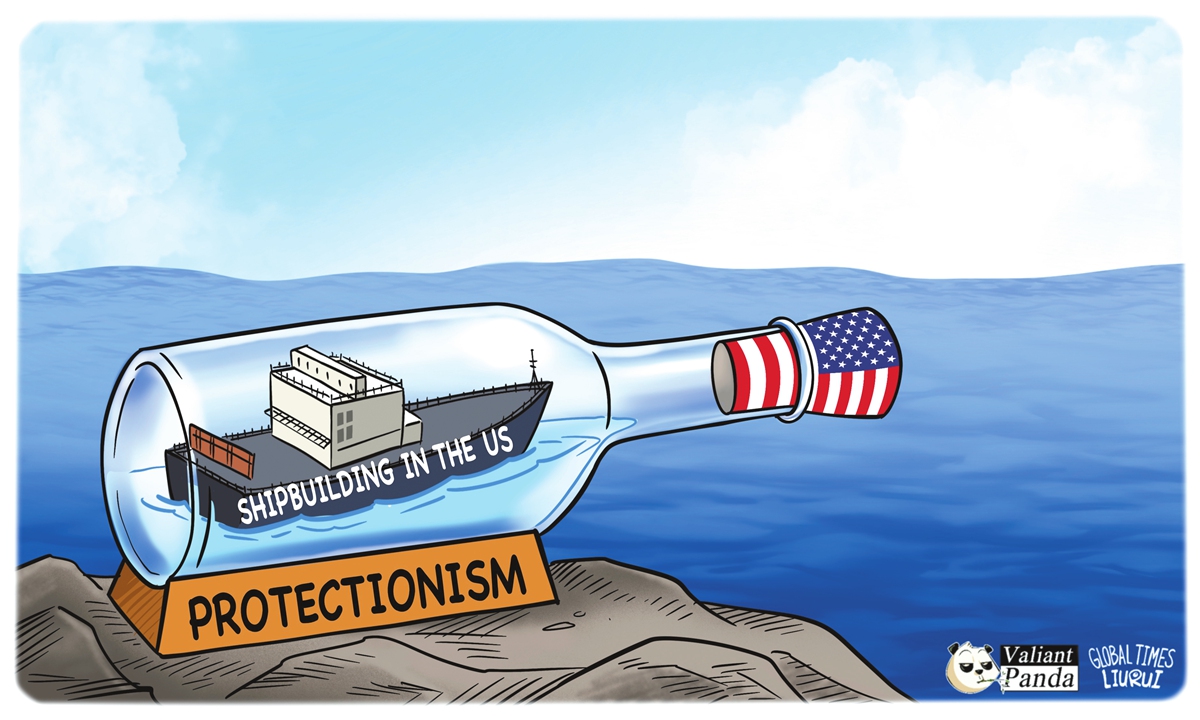
Trapped in 'protection'. Illustration: Liu Rui/GT
The US wants to build more ships. Indeed, this is not simple, especially since the US is not able to achieve this by undermining the ability of others, notably China.
A public hearing on the US administration's proposed levies on Chinese ships docking in the US was held on Monday. Business interests, from US farmers to global ocean carriers, have already warned of severe economic damage from this proposal.
From a practical standpoint, the plan to build more ships faces numerous challenges due to the decline of the manufacturing industry and the issue of labor shortages. Reversing the decline of the manufacturing sector is not an easy task, and addressing the labor shortage will also require long-term efforts.
Despite the fact that the goal of bringing more shipbuilding back to the US is at odds with reality, the proposal is part of a broader and ambitious White House strategy to revive US shipbuilding, something the new administration has been obsessed with since taking office. Early this month, the Trump administration promised to establish a new office of shipbuilding within the White House to revitalize the industry and bolster American naval strength.
The not-so-subtle subtext of these moves is, like so many other ones from the US in recent years, to target China as a supposed threat to US national security. These actions are just the latest in a series of recent inflammatory and poorly planned moves by the US, which names another country as an enemy but will only serve to further destabilize our own economy.
The US attempts at tariffs this year on goods from Mexico, Canada and China have contributed to a great deal of uncertainty in American markets, as confused companies are left unsure of what the US' actual long-term posture will be on tariffs. Without that certainty, US companies are unlikely to have the confidence needed to invest the billions of dollars required to create new domestic shipbuilding plants. Penalizing the use of Chinese-made ships is akin to fighting the wind, as China accounts for about half of all globally delivered ships.
The new US measures and classifications are heavy on nationalist rhetoric but lacking in details, and experts suggest that they are likely to face legal challenges, which may further dissuade American companies from engaging in shipbuilding.
At the same time, American media and think tanks have been quick to label China's naval dominance a threat to US national security, without any substantial evidence. A report released in mid-March by the Center for Strategic and International Studies claimed that China having grown to be the dominant player in shipbuilding poses serious economic and national security challenges for the US and its allies. Apparently, the purpose of this report aligns with the government's attempt to counter China. While it is true that China has had the good sense to build its seafaring capacity both of the military and commercial variety, this type of public-private partnership was once a hallmark of American economic strategy and led to our own golden age of prosperity in the mid-20th century.
To summarize, the US is in no position to call other nations a threat to global security. All of the US' moves to revive its shipbuilding are very much in the spirit of the tabled SHIPS for America Act which explicitly states that its main goal is to build the US' war-making capacity by increasing our current meager shipbuilding capacity. The US media has already pointed out that the hollowing out of the vast American shipbuilding industry that the US Navy depends on could hobble it in a war with China.
After all, what the US worries about most is losing its naval dominance to China. However, it is clear that the US plan to rejuvenate its shipbuilding industry at China's expense can hardly succeed and is sure to backfire.
The author is a Chicago-based columnist covering US politics & culture. He is also a university English & critical journalism instructor. opinion@globaltimes.com.cn




